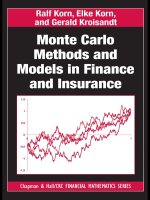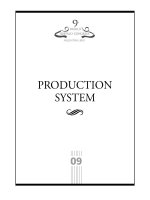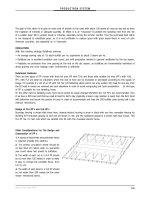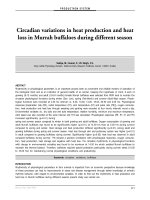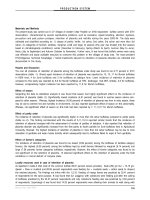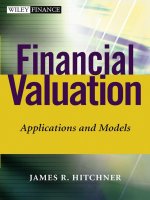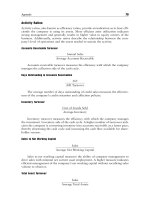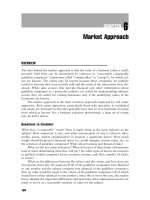Microeconomic markets methods and models
Bạn đang xem bản rút gọn của tài liệu. Xem và tải ngay bản đầy đủ của tài liệu tại đây (1.28 MB, 425 trang )
MICROECONOMICS
Markets, Methods & Models
by Douglas Curtis and Ian Irvine
Open text in collaboration with:
LYRYX SERVICE COURSE SOLUTIONS
*Creative Commons License (CC BY-NC-SA)
This text, including the art and illustrations, are available under the Creative Commons license (CC BY-NCSA), allowing anyone to copy and redistribute the material in any medium or format.
a
d
v a
n c i
n
g
l e
a
r n
i
n
g
LYRYX SERVICE COURSE SOLUTIONS
The form of this book is completely new to the Canadian market. As authors we have many years
of experience in hard copy book publishing with a major international publisher. This time we are
publishing an open text in collaboration with Lyryx Learning, supporting open content as part of
their Lyryx Service Course Solutions (LSCS) products & services.
While there is no requirement that users of the book do anything more than download the pdf files
and use them for non-profit educational purposes, the texts are aligned with LSCS products and
services offering the following benefits.
OPEN TEXT
The text can be downloaded in electronic format, printed, and can be distributed to students at no
cost. Instructors who adopt Lyryx Service Course Solutions may obtain the relevant original text
files from the authors if the instructors decide they wish to amplify certain sections for their own
students. In collaboration with the authors, Lyryx will also adapt the content and provide custom
editions for specific courses.
ONLINE ASSESSMENT
Lyryx has developed corresponding formative online assessment for homework and quizzes. These
are genuine questions for the subject and adapted to the content. Student answers are carefully analyzed by the system and personalized feedback is immediately provided to help students improve
on their work. Lyryx provides all the tools required to manage your online assessment including
student grade reports and student performance statistics.
INSTRUCTOR SUPPLEMENTS
Among other things the book is accompanied by a full set of slides for instructors and students.
These are available in their original format, and consequently can be further adapted by instructors.
An Exam Builder tool is also available allowing instructors to easily create paper quizzes and
exams.
SUPPORT
Lyryx provides all of the support you and your students need! Starting from the course preparation time to beyond the end of the course, the Lyryx staff is available 7 days/week to provide
assistance. This may include adapting the text, managing multiple sections of the course, providing course supplements, as well as timely assistance to students with registration, navigation, and
daily organization.
Contact Lyryx!
ii
Microeconomics: Markets, Methods & Models
Douglas Curtis and Ian Irvine
Version 2014
—
Revision A
The content in this version is differentiated from the 2013 version solely by minor editorial adjustments.
Copyright
This work is licensed under a Creative Commons Attribution-NonCommercial-ShareAlike 3.0 Unported License.
To view a copy of this license, visit />i
Contents
Part One: The Building Blocks
3
1
Introduction to key ideas
5
1.1
What’s it all about? . . . . . . . . . . . . . . . . . . . . . . . . . . . . . . . . . .
5
1.2
Understanding through the use of models . . . . . . . . . . . . . . . . . . . . . . 10
1.3
Opportunity cost and the market . . . . . . . . . . . . . . . . . . . . . . . . . . . 11
1.4
A model of exchange and specialization . . . . . . . . . . . . . . . . . . . . . . . 12
1.5
Economy-wide production possibilities . . . . . . . . . . . . . . . . . . . . . . . 15
1.6
Aggregate output, growth and business cycles . . . . . . . . . . . . . . . . . . . . 18
2
3
Theories, models and data
27
2.1
Observations, theories and models . . . . . . . . . . . . . . . . . . . . . . . . . . 28
2.2
Variables, data and index numbers . . . . . . . . . . . . . . . . . . . . . . . . . . 29
2.3
Testing economic models & analysis . . . . . . . . . . . . . . . . . . . . . . . . . 39
2.4
Diagrams and economic analysis . . . . . . . . . . . . . . . . . . . . . . . . . . . 42
2.5
Ethics, efficiency and beliefs . . . . . . . . . . . . . . . . . . . . . . . . . . . . . 44
The classical marketplace – demand and supply
iii
55
Contents
3.1
Trading . . . . . . . . . . . . . . . . . . . . . . . . . . . . . . . . . . . . . . . . 55
3.2
The market’s building blocks . . . . . . . . . . . . . . . . . . . . . . . . . . . . . 56
3.3
Demand and supply curves . . . . . . . . . . . . . . . . . . . . . . . . . . . . . . 60
3.4
Other influences on demand . . . . . . . . . . . . . . . . . . . . . . . . . . . . . 63
3.5
Other influences on supply . . . . . . . . . . . . . . . . . . . . . . . . . . . . . . 68
3.6
Simultaneous supply and demand impacts . . . . . . . . . . . . . . . . . . . . . . 71
3.7
Market interventions . . . . . . . . . . . . . . . . . . . . . . . . . . . . . . . . . 72
3.8
Individual and market functions . . . . . . . . . . . . . . . . . . . . . . . . . . . 76
Part Two: Responsiveness and the Value of Markets
83
4
85
5
Measures of response: elasticities
4.1
Price responsiveness of demand . . . . . . . . . . . . . . . . . . . . . . . . . . . 85
4.2
Price elasticity and expenditure . . . . . . . . . . . . . . . . . . . . . . . . . . . . 94
4.3
The time horizon and inflation . . . . . . . . . . . . . . . . . . . . . . . . . . . . 97
4.4
Cross-price elasticities . . . . . . . . . . . . . . . . . . . . . . . . . . . . . . . . 97
4.5
The income elasticity of demand . . . . . . . . . . . . . . . . . . . . . . . . . . . 98
4.6
Elasticity of supply . . . . . . . . . . . . . . . . . . . . . . . . . . . . . . . . . . 100
4.7
Elasticities and tax incidence . . . . . . . . . . . . . . . . . . . . . . . . . . . . . 101
4.8
Identifying demand and supply elasticities . . . . . . . . . . . . . . . . . . . . . . 104
Welfare economics and externalities
111
5.1
Equity and efficiency . . . . . . . . . . . . . . . . . . . . . . . . . . . . . . . . . 111
5.2
Consumer and producer surplus . . . . . . . . . . . . . . . . . . . . . . . . . . . 112
iv
Contents
5.3
Efficient market outcomes . . . . . . . . . . . . . . . . . . . . . . . . . . . . . . 117
5.4
Taxation, surplus and efficiency . . . . . . . . . . . . . . . . . . . . . . . . . . . 118
5.5
Market failures – externalities . . . . . . . . . . . . . . . . . . . . . . . . . . . . 122
5.6
Other market failures . . . . . . . . . . . . . . . . . . . . . . . . . . . . . . . . . 126
5.7
Environmental policy and climate change . . . . . . . . . . . . . . . . . . . . . . 126
5.8
Equity, justice, and efficiency . . . . . . . . . . . . . . . . . . . . . . . . . . . . . 134
Part Three: Decision Making by Consumer and Producers
143
6
145
7
8
Individual choice
6.1
Rationality . . . . . . . . . . . . . . . . . . . . . . . . . . . . . . . . . . . . . . . 145
6.2
Choice with measurable utility . . . . . . . . . . . . . . . . . . . . . . . . . . . . 147
6.3
Choice with ordinal utility . . . . . . . . . . . . . . . . . . . . . . . . . . . . . . 153
6.4
Applications of indifference analysis . . . . . . . . . . . . . . . . . . . . . . . . . 163
Firms, investors and capital markets
175
7.1
Business organization . . . . . . . . . . . . . . . . . . . . . . . . . . . . . . . . . 175
7.2
Profit, ownership and corporate goals . . . . . . . . . . . . . . . . . . . . . . . . . 179
7.3
Risk and the investor . . . . . . . . . . . . . . . . . . . . . . . . . . . . . . . . . 180
7.4
Diminishing marginal utility and risk . . . . . . . . . . . . . . . . . . . . . . . . . 183
7.5
Real returns to investment . . . . . . . . . . . . . . . . . . . . . . . . . . . . . . 186
7.6
Financing the risky firm: diversification . . . . . . . . . . . . . . . . . . . . . . . 187
Production and cost
197
v
Contents
8.1
Efficient production . . . . . . . . . . . . . . . . . . . . . . . . . . . . . . . . . . 197
8.2
The time frame . . . . . . . . . . . . . . . . . . . . . . . . . . . . . . . . . . . . 199
8.3
Production in the short run . . . . . . . . . . . . . . . . . . . . . . . . . . . . . . 200
8.4
Costs in the short run . . . . . . . . . . . . . . . . . . . . . . . . . . . . . . . . . 204
8.5
Fixed costs and sunk costs . . . . . . . . . . . . . . . . . . . . . . . . . . . . . . 208
8.6
Long run production and costs . . . . . . . . . . . . . . . . . . . . . . . . . . . . 209
8.7
Technological change and globalization . . . . . . . . . . . . . . . . . . . . . . . 215
8.8
Clusters, learning by doing, scope economies . . . . . . . . . . . . . . . . . . . . 216
Part Four: Market Structures
223
9
225
Perfect competition
9.1
The perfect competition paradigm . . . . . . . . . . . . . . . . . . . . . . . . . . 225
9.2
Market characteristics . . . . . . . . . . . . . . . . . . . . . . . . . . . . . . . . . 227
9.3
The firm’s supply decision . . . . . . . . . . . . . . . . . . . . . . . . . . . . . . 228
9.4
Dynamics: entry and exit . . . . . . . . . . . . . . . . . . . . . . . . . . . . . . . 234
9.5
Long run industry supply . . . . . . . . . . . . . . . . . . . . . . . . . . . . . . . 237
9.6
Globalization and technological change . . . . . . . . . . . . . . . . . . . . . . . 239
9.7
Efficient resource allocation . . . . . . . . . . . . . . . . . . . . . . . . . . . . . 240
10 Monopoly
247
10.1 Monopolies . . . . . . . . . . . . . . . . . . . . . . . . . . . . . . . . . . . . . . 247
10.2 Profit maximizing behaviour . . . . . . . . . . . . . . . . . . . . . . . . . . . . . 251
10.3 Long run choices . . . . . . . . . . . . . . . . . . . . . . . . . . . . . . . . . . . 257
vi
Contents
10.4 Output inefficiency . . . . . . . . . . . . . . . . . . . . . . . . . . . . . . . . . . 259
10.5 Price discrimination . . . . . . . . . . . . . . . . . . . . . . . . . . . . . . . . . . 261
10.6 Cartels: acting like a monopolist . . . . . . . . . . . . . . . . . . . . . . . . . . . 265
10.7 Rent-seeking . . . . . . . . . . . . . . . . . . . . . . . . . . . . . . . . . . . . . 268
10.8 Technology and innovation . . . . . . . . . . . . . . . . . . . . . . . . . . . . . . 269
11 Imperfect competition
275
11.1 Imperfect competitors . . . . . . . . . . . . . . . . . . . . . . . . . . . . . . . . . 275
11.2 Performance-based measures of structure – market power . . . . . . . . . . . . . . 278
11.3 Monopolistic competition . . . . . . . . . . . . . . . . . . . . . . . . . . . . . . . 279
11.4 Oligopoly and games . . . . . . . . . . . . . . . . . . . . . . . . . . . . . . . . . 282
11.5 Duopoly and Cournot games . . . . . . . . . . . . . . . . . . . . . . . . . . . . . 286
11.6 Comparing market structures . . . . . . . . . . . . . . . . . . . . . . . . . . . . . 290
11.7 Entry, exit & potential competition . . . . . . . . . . . . . . . . . . . . . . . . . . 291
Part Five: The Factors of Production
301
12 Labour and capital
303
12.1 Labour – a derived demand . . . . . . . . . . . . . . . . . . . . . . . . . . . . . . 303
12.2 Firm versus industry demand . . . . . . . . . . . . . . . . . . . . . . . . . . . . . 308
12.3 The supply side of the market . . . . . . . . . . . . . . . . . . . . . . . . . . . . . 309
12.4 Labour-market equilibrium and mobility . . . . . . . . . . . . . . . . . . . . . . . 312
12.5 The market for capital . . . . . . . . . . . . . . . . . . . . . . . . . . . . . . . . . 316
12.6 Capital services . . . . . . . . . . . . . . . . . . . . . . . . . . . . . . . . . . . . 320
vii
Contents
12.7 Land . . . . . . . . . . . . . . . . . . . . . . . . . . . . . . . . . . . . . . . . . . 323
13 Human capital and the income distribution
331
13.1 Human capital . . . . . . . . . . . . . . . . . . . . . . . . . . . . . . . . . . . . . 332
13.2 Productivity and education . . . . . . . . . . . . . . . . . . . . . . . . . . . . . . 332
13.3 On-the-job training . . . . . . . . . . . . . . . . . . . . . . . . . . . . . . . . . . 336
13.4 Education as signalling . . . . . . . . . . . . . . . . . . . . . . . . . . . . . . . . 337
13.5 Education returns and quality . . . . . . . . . . . . . . . . . . . . . . . . . . . . . 338
13.6 Discrimination . . . . . . . . . . . . . . . . . . . . . . . . . . . . . . . . . . . . 339
13.7 The income distribution . . . . . . . . . . . . . . . . . . . . . . . . . . . . . . . . 340
Part Six: Government and Trade
351
14 Government
353
14.1 Market failure . . . . . . . . . . . . . . . . . . . . . . . . . . . . . . . . . . . . . 354
14.2 Fiscal federalism: taxing and spending . . . . . . . . . . . . . . . . . . . . . . . . 359
14.3 Federal-provincial fiscal relations . . . . . . . . . . . . . . . . . . . . . . . . . . . 361
14.4 Government-to-individual transfers . . . . . . . . . . . . . . . . . . . . . . . . . . 363
14.5 Regulation and competition policy . . . . . . . . . . . . . . . . . . . . . . . . . . 365
15 International trade
375
15.1 Trade in our daily lives . . . . . . . . . . . . . . . . . . . . . . . . . . . . . . . . 375
15.2 Canada in the world economy . . . . . . . . . . . . . . . . . . . . . . . . . . . . 376
15.3 Comparative advantage: the gains from trade . . . . . . . . . . . . . . . . . . . . 378
viii
Contents
15.4 Returns to scale . . . . . . . . . . . . . . . . . . . . . . . . . . . . . . . . . . . . 383
15.5 Trade barriers: tariffs, subsidies and quotas. . . . . . . . . . . . . . . . . . . . . . 384
15.6 The politics of protection . . . . . . . . . . . . . . . . . . . . . . . . . . . . . . . 390
15.7 Institutions governing trade . . . . . . . . . . . . . . . . . . . . . . . . . . . . . . 393
ix
About
About the Authors
Doug Curtis is a specialist in macroeconomics. He is the author of twenty research papers on
fiscal policy, monetary policy, and economic growth and structural change. He has also prepared
research reports for Canadian industry and government agencies and authored numerous working
papers. He completed his PhD at McGill University, and has held visiting appointments at the
University of Cambridge and the University of York in the United Kingdom. His current research
interests are monetary and fiscal policy rules, and the relationship between economic growth and
structural change. He is Professor Emeritus of Economics at Trent University in Peterborough,
Ontario, and Sessional Adjunct Professor at Queen’s University in Kingston, Ontario.
Ian Irvine is a specialist in microeconomics, public economics, economic inequality and health
economics. He is the author of some thirty research papers in these fields. He completed his PhD
at the University of Western Ontario, has been a visitor at the London School of Economics, the
University of Sydney, the University of Colorado, University College Dublin and the Economic
and Social Research Institute. His current research interests are in tobacco use and taxation, and
Canada’s Employment Insurance and Welfare systems. He has done numerous studies for the
Government of Canada, and is currently a Professor of Economics at Concordia University in
Montreal.
Our Philosophy
Microeconomics: Markets, Methods and Models focuses upon the material that students need to
cover in a first introductory course. It is slightly more compact than the majority of principles
books in the Canadian marketplace. Decades of teaching experience and textbook writing has led
the authors to avoid the encyclopedic approach that characterizes the recent trends in textbooks.
Consistent with this approach, there are no appendices or ‘afterthought’ chapters. If important
material is challenging then it is still included in the main body of the text; it is not relegated
elsewhere for a limited audience; the text makes choices on what issues and topics are important in
an introductory course. This philosophy has resulted in a Micro book of just 15 chapters, of which
Chapters 1 through 3 plus Chapter 15 are common to both Micro and Macro.
Examples are domestic and international in their subject matter and are of the modern era – consumers buy iPods, snowboards and jazz, not so much coffee and hamburgers. Globalization is a
recurring theme.
The title is intended to be informative. Students are introduced to the concepts of models early,
and the working of such models is illustrated in every chapter. Calculus is avoided; but students
learn to master and solve linear models. Hence straight line equations.
1
About
Structure of the Text
Microeconomics: Markets, Methods and Models provides a concise, yet complete, coverage of
introductory microeconomic theory, application and policy in a Canadian and global environment.
Our beginning is orthodox: we explain and develop the standard tools of analysis in the discipline.
Economic policy is about the well-being of the economy’s participants, and economic theory
should inform economic policy. So we investigate the meaning of ‘well-being’ in the context
of an efficient use of the economy’s resources early in the text.
We next develop an understanding of individual optimizing behaviour. This behaviour in turn is
used to link household decisions on savings with firms’ decisions on production, expansion and
investment. A natural progression is to explain production and cost structures.
From the individual level of household and firm decision making, the text then explores behaviour
in a variety of different market structures.
Markets for the inputs in the productive process – capital and labour – are a natural component of
firm-level decisions. But education and human capital are omnipresent concepts and concerns in
the modern economy, so we devote a complete chapter to them.
The book then examines the role of a major and important non-market player in the economy –
the government, and progresses to develop the key elements in the modern theory of international
trade.
Opportunity cost, a global economy and behavioural responses to incentives are the dominant
themes.
2
Part One
The Building Blocks
1. Introduction to key ideas
2. Theories, models and data
3. The classical marketplace – demand and supply
Economics is a social science; it analyzes human interactions in a scientific manner. We begin
by defining the central aspects of this social science – trading, the marketplace, opportunity cost
and resources. We explore how producers and consumers interact in society. Trade is central to
improving the living standards of individuals. This material forms the subject matter of Chapter 1.
Methods of analysis are central to any science. Consequently we explore how data can be displayed
and analyzed in order to better understand the economy around us in Chapter 2. Understanding the
world is facilitated by the development of theories and models and then testing such theories with
the use of data-driven models.
Trade is critical to individual well-being, whether domestically or internationally. To understand
this trading process we analyze the behaviour of suppliers and buyers in the marketplace. Markets
are formed by suppliers and demanders coming together for the purpose of trading. Thus, demand
and supply are examined in Chapter 3 in tabular, graphical and mathematical form.
Chapter 1
Introduction to key ideas
In this chapter we will explore:
1. What it is all about
2. The use of models in science
3. Opportunity cost
4. Exchange and specialization
5. Production possibilities for the economy
6. Output, growth and cycles
1.1
What’s it all about?
The big issues
Economics is the study of human behaviour. Since it uses scientific methods it is called a social
science. We study human behaviour to better understand and improve our world. During his
acceptance speech, a recent Nobel Laureate in Economics suggested:
Economics, at its best, is a set of ideas and methods for the improvement of society. It
5
1.1. What’s it all about?
is not, as so often seems the case today, a set of ideological rules for asserting why we
cannot face the challenges of stagnation, job loss and widening inequality.
Christopher Sims, Nobel Laureate in Economics 2011
This is an elegant definition of economics and serves as a timely caution about the perils of ideology. Economics evolves continuously as current observations and experience provide new evidence about economic behaviour and relationships. Inference and policy recommendations based
on earlier theories, observations and institutional structures require constant analysis and updating
if they are to furnish valuable responses to changing conditions and problems.
Much of today’s developed world faces severe challenges as a result of the financial crisis that
began in 2008. Unemployment rates among young people are at historically high levels in several
economies, government balance sheets are in disarray, and inequality is on the rise. In addition
to the challenges posed by this severe economic cycle, the world simultaneously faces structural
upheaval: overpopulation, climate change, political instability and globalization challenge us to
understand and modify our behaviour.
These challenges do not imply that our world is deteriorating. Literacy rates have been rising
dramatically in the developing world for decades; child mortality has plummeted; family size is a
fraction of what it was 50 years ago; prosperity is on the rise in much of Asia; life expectancy is
increasing universally and deaths through wars are in a state of long term decline.
These developments, good and bad, have a universal character and affect billions of individuals.
They involve an understanding of economies as large organisms with interactive components. The
study of economies as large interactive systems is called macro. Technically, macroeconomics
approaches the economy as a complete system with feedback effects among sectors that determine
national economic performance. Feedback within the system mean we cannot aggregate from
observations on one household or business to the economy as a whole. Application Box 1.1 gives
an example.
Macroeconomics studies the economy as system in which feedbacks among sectors determine
national output, employment and prices.
Individual behaviours
Individual behaviour underlies much of our social and economic interactions. Some individual
behaviours are motivated by self-interest, others are socially motivated. The Arab Spring of 2011
was sparked by individual actions in North Africa that subsequently became mass movements.
These movements were aimed at improving society at large. Globalization, with its search for
ever less costly production sources in Asia and elsewhere, is in part the result of cost-reducing and
6
Chapter 1. Introduction to key ideas
profit-maximizing behaviour on the part of developed-world entrepreneurs, and in part attributable
to governments opening their economies up to the forces of competition, in the hope that living
standards will improve across the board. The increasing income share that accrues to the top one
percent of our population in North America and elsewhere is primarily the result of individual
self-interest.
At the level of the person or organization, economic actions form the subject matter of microeconomics. Formally, microeconomics is the study of individual behaviour in the context of scarcity.
Microeconomics is the study of individual behaviour in the context of scarcity.
Individual economic decisions need not be world-changing events, or motivated by a search for
profit. For example, economics is also about how we choose to spend our time and money. There
are quite a few options to choose from: sleep, work, study, food, shelter, transportation, entertainment, recreation and so forth. Because both time and income are limited we cannot do all things
all the time. Many choices are routine or are driven by necessity. You have to eat and you need
a place to live. If you have a job you have committed some of your time to work, or if you are
a student some of your time is committed to lectures and study. There is more flexibility in other
choices. Critically, microeconomics seeks to understand and explain how we make choices and
how those choices affect our behaviour in the workplace and society.
7
1.1. What’s it all about?
Finance Minister Jim Flaherty and Bank of Canada Governor Mark Carney in 2011 urged
Canadian households to increase their savings in order to reduce their record high debt-toincome ratio. On an individual level this makes obvious sense. If you could save more and
spend less you could pay down the balances on credit cards, your line of credit, mortgage
and other debts.
But one household’s spending is another household’s income. For the economy as a system,
an increase in households’ saving from say 5 percent of income to 10 percent reduces spending accordingly. But lower spending by all households will reduce the purchases of goods
and services produced in the economy, and therefore has the potential to reduce national incomes. Furthermore, with lower income the troublesome debt-to-income ratio will not fall,
as originally intended. Hence, while higher saving may work for one household in isolation,
higher saving by all households may not. The interactions and feedback in the economic
system create a ‘paradox of thrift.’
The paradox can also create problems for government finances and debt. Following the
recession that began in 2008/09, many European economies with high debt loads cut spending
and increased taxes to in order to balance their fiscal accounts. But this fiscal austerity
reduced the national incomes on which government tax revenues are based, making deficit
and debt problems even more problematic. Feedback effects, within and across economies,
meant that European Union members could not all cut deficits and debt simultaneously.
Application Box 1.1: The Paradox of Thrift
A critical element in making choices is that there exists a scarcity of time, or income or productive
resources. Decisions are invariably subject to limits or constraints, and it is these constraints that
make decisions both challenging and scientific.
Microeconomics also concerns business choices. How does a business use its funds and management skill to produce goods and services? The individual business operator or firm has to decide
what to produce, how to produce it, how to sell it and in many cases, how to price it. To make and
sell pizza, for example, the pizza parlour needs, in addition to a source of pizza ingredients, a store
location (land), a pizza oven (capital), a cook and a sales person (labour). Payments for the use of
these inputs generate income to those supplying them. If revenue from the sale of pizzas is greater
than the costs of production, the business earns a profit for the owner. A business fails if it cannot
cover its costs.
In these micro-level behaviours the decision makers have a common goal: to do as well as he or
she can, given the constraints imposed by the operating environment. The individual wants to mix
work and leisure in a way that makes her as happy or contented as possible. The entrepreneur
aims at making a profit. These actors, or agents as we sometimes call them, are maximizing. Such
maximizing behaviour is a central theme in this book and in economics at large.
8
Chapter 1. Introduction to key ideas
Markets and government
Markets play a key role in coordinating the choices of individuals with the decisions of business.
In modern market economies goods and services are supplied by both business and government.
Hence we call them mixed economies. Some products or services are available to those who wish
to buy them and have the necessary income – as in cases like coffee and wireless services. Other
services are provided to all people through government programs like law enforcement and health
care.
In a mixed economy goods and services are supplied both by private suppliers and government.
Markets offer the choice of a wide range of goods and services at various prices. Individuals can
use their incomes to decide the pattern of expenditures and the bundle of goods and services they
prefer. Businesses sell goods and services in the expectation that the market price will cover costs
and yield a profit.
The market also allows for specialization and separation between production and use. Rather than
each individual growing her own food, for example, she can sell her time or labour to employers in
return for income. That income can then support her desired purchases. If businesses can produce
food more cheaply than individuals the individual obviously gains from using the market – by both
having the food to consume, and additional income with which to buy other goods and services.
Economics seeks to explain how markets and specialization might yield such gains for individuals
and society.
We will represent individuals and firms by envisaging that they have explicit objectives – to maximize their happiness or profit. However, this does not imply that individuals and firms are concerned only with such objectives. On the contrary, much of microeconomics and macroeconomics
focuses upon the role of government: how it manages the economy through fiscal and monetary
policy, how it redistributes through the tax-transfer system, how it supplies information to buyers
and sets safety standards for products.
Since governments perform all of these socially-enhancing functions, in large measure governments reflect the social ethos of voters. So, while these voters may be maximizing at the individual
level in their everyday lives, and our models of human behaviour in microeconomics certainly emphasize this optimization, economics does not see individuals and corporations as being devoid of
civic virtue or compassion, nor does it assume that only market-based activity is important. Governments play a central role in modern economies, to the point where they account for more than
one third of all economic activity in the modern mixed economy.
While governments supply goods and services in many spheres, governments are fundamental to
the just and efficient functioning of society and the economy at large. The provision of law and
order, through our legal system broadly defined, must be seen as more than simply accounting for
9
1.2. Understanding through the use of models
some percentage our national economic activity. Such provision supports the whole private sector
of the economy. Without a legal system that enforces contracts and respects property rights the
private sector of the economy would diminish dramatically as a result of corruption, uncertainty
and insecurity. It is the lack of such a secure environment in many of the world’s economies that
inhibits their growth and prosperity.
Let us consider now the methods of economics, methods that are common to science-based disciplines.
1.2
Understanding through the use of models
Most students have seen an image of Ptolemy’s concept of our Universe. Planet Earth forms the
centre, with the other planets and our sun revolving around it. The ancients’ anthropocentric view
of the universe necessarily placed their planet at the centre. Despite being false, this view of our
world worked reasonably well – in the sense that the ancients could predict celestial motions, lunar
patterns and the seasons quite accurately.
More than one Greek astronomer believed that it was more natural for smaller objects such as the
earth to revolve around larger objects such as the sun, and they knew that the sun had to be larger
as a result of having studied eclipses of the moon and sun. Nonetheless, the Ptolemaic description
of the universe persisted until Copernicus wrote his treatise “On the Revolutions of the Celestial
Spheres” in the early sixteenth century. And it was another hundred years before the Church
accepted that our corner of the universe is heliocentric. During this time evidence accumulated as
a result of the work of Brahe, Kepler and Galileo. The time had come for the Ptolemaic model of
the universe to be supplanted with a better model.
All disciplines progress and develop and explain themselves using models of reality. A model is
a formalization of theory that facilitates scientific inquiry. Any history or philosophy of science
book will describe the essential features of a model. First, it is a stripped down, or reduced, version
of the phenomenon that is under study. It incorporates the key elements while disregarding what
are considered to be secondary elements. Second, it should accord with reality. Third, it should be
able to make meaningful predictions. Ptolemy’s model of the known universe met these criteria: it
was not excessively complicated (for example distant stars were considered as secondary elements
in the universe and were excluded); it corresponded to the known reality of the day, and made
pretty good predictions. Evidently not all models are correct and this was the case here.
A model is a formalization of theory that facilitates scientific inquiry.
In short, models are frameworks we use to organize how we think about a problem. Economists
sometimes interchange the terms theories and models, though they are conceptually distinct. A
10
Chapter 1. Introduction to key ideas
theory is a logical view of how things work, and is frequently formulated on the basis of observation. A model is a formalization of the essential elements of a theory, and has the characteristics
we described above. As an example of an economic model, suppose we theorize that a household’s
expenditure depends on its key characteristics: such a model might specify that wealth, income,
and household size determine its expenditures, while it might ignore other, less important, traits
such as the household’s neighbourhood or its religious beliefs. The model reduces and simplifies the theory to manageable dimensions. From such a reduced picture of reality we develop an
analysis of how an economy and its components work.
A theory is a logical view of how things work, and is frequently formulated on the basis of
observation.
An economist uses a model as a tourist uses a map. Any city map misses out some detail—traffic
lights and speed bumps, for example. But with careful study you can get a good idea of the best
route to take. Economists are not alone in this approach; astronomers, meteorologists, physicists,
and genetic scientists operate similarly. Meteorologists disregard weather conditions in South
Africa when predicting tomorrow’s conditions in Winnipeg. Genetic scientists concentrate on the
interactions of limited subsets of genes that they believe are the most important for their purpose.
Even with huge computers, all of these scientists build models that concentrate on the essentials.
1.3
Opportunity cost and the market
Individuals face choices at every turn: In deciding to go to the hockey game tonight, you may have
to forgo a concert; or you will have to forgo some leisure time this week order to earn additional
income for the hockey game ticket. Indeed, there is no such thing as a free lunch, a free hockey
game or a free concert. In economics we say that these limits or constraints reflect opportunity
cost. The opportunity cost of a choice is what must be sacrificed when a choice is made. That
cost may be financial; it may be measured in time, or simply the alternative foregone.
The opportunity cost of a choice is what must be sacrificed when a choice is made.
Opportunity costs play a determining role in markets. It is precisely because individuals and organizations have different opportunity costs that they enter into exchange agreements. Suppose you
are a skilled plumber, but an unskilled gardener, while your neighbour is a skilled gardener, but
an unskilled plumber, In this situation you and your neighbour not only have different capabilities,
you also have different opportunity costs, and you could gain by trading your skills. Here’s why.
Fixing a leaking pipe has a low opportunity cost for you in terms of time: you can do it quickly.
But pruning your apple trees will be costly because you must first learn how to avoid killing them
11
1.4. A model of exchange and specialization
and this may require many hours. Your neighbour has exactly the same problem, with the tasks in
reverse positions. In a sensible world you would fix your own pipes and your neighbour’s pipes,
and she would ensure the health of the apple trees in both backyards.
Reflecting upon this ‘sensible’ solution – one that involves each of you achieving your objectives
while minimizing the time input – you will quickly realize that it resembles the solution provided
by the marketplace. You may not have a gardener as a neighbour, so you buy the services of a
gardener in the marketplace. Likewise, your immediate neighbour may not need a leaking pipe
repaired, but many others in your neighbourhood do, so you sell your service to them. You each
specialize in the performance of specific tasks as a result of having different opportunity costs
or different efficiencies. Let us now develop a model of exchange to illustrate the advantages
of specialization and trade, and hence the markets that facilitate these activities. This model is
developed with the help of some two-dimensional graphics.
1.4
A model of exchange and specialization
We have two producers and two goods: Amanda and Zoe produce vegetables (V ) and/or fish (F).
Their production capabilities are defined in Table 1.1 and in Figure 1.1, where the quantity of V
appears on the vertical axis and the quantity of F on the horizontal axis. Zoe and Amanda each
have 36-hour weeks and they devote that time to producing the two goods. But their efficiencies
differ: Amanda requires two hours to produce a unit of V and three hours for a unit of F. As a
consequence, if she devotes all of her time to V she can produce 18 units, or if she devotes all of
her time to F she can produce 12 units. Or, she could share her time between the two.
Amanda
Zoe
Hours/
fish
3
2
Hours/
vegetable
2
4
Fish
production
12
18
Vegetable
production
18
9
Table 1.1: Production possibilities in a two-person economy
Each producer has a time allocation of 36 hours. By allocating total time to one activity,
Amanda can produce 12F or 18V , Zoe can produce 18F or 9V . By splitting their time each
person can also produce a combination of the two.
12
Chapter 1. Introduction to key ideas
Vegetable
18
Amanda specializes
Amanda’s PPF
Amanda’s initial consumption
(6,9)
9
Zoe’s initial consumption
Zoe’s PPF
Zoe specializes
(9,4.5)
Fish
12
18
Figure 1.1: Absolute advantage – production
Amanda’s initial consumption is (6,9) and Zoe’s is (9,4.5). With specialization they can produce a greater total (18,18) than when operating individually. Hence, if they trade, after specializing, they each have the potential to consume more.
In Figure 1.1 Amanda’s capacity is represented by the line that meets the vertical axis at 18 and the
horizontal axis at 12. The vertical point indicates that she can produce 18 units of V if she produces
zero units of F – keep in mind that where V has a value of 18, Amanda has no time left for fish
production. Likewise, if she devotes all of her time to fish she can produce 12 units, since each unit
requires 3 of her 36 hours. The point F = 12 is thus another possibility for her. In addition to these
two possibilities, which we can term ’specialization’, she could allocate her time to producing
some of each good. For example, by dividing her 36 hours equally she could produce 6 units of F
and 9 units of V . A little computation will quickly convince us that different allocations of her time
will lead to combinations of the two goods that lie along a straight line joining the specialization
points. We will call this straight line Amanda’s production possibility frontier (PPF): it is the
combination of goods she can produce while using all of her resources – time. She could not
produce combinations of goods represented by points beyond this line (to the top right). She could
indeed produce combinations below it (lower left) – for example a combination of 4 units of V
and 4 units of F; but such points would not require all of her time. The (4,4) combination would
require just 20 hours. In sum, points beyond this line are not feasible, and points within it do not
require all of her time resources.
The production possibility frontier (PPF) defines the combination of goods that can be produced using all of the resources available.
Having developed Amanda’s PPF, it is straightforward to develop a corresponding set of possibilities for Zoe. If she requires 4 hours to produce a unit of V and 2 hours to produce a unit of F, then
her 36 hours will enable her to specialize in 9 units of V or 18 units of F; or she could produce a
combination represented by the straight line that joins these two specialty extremes.
13
